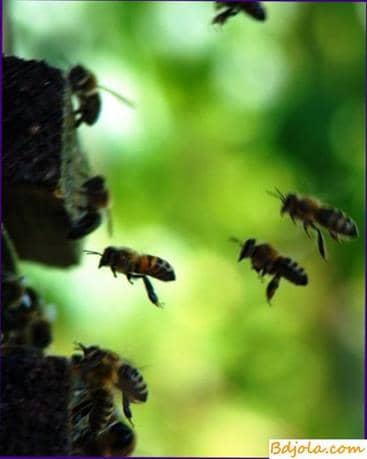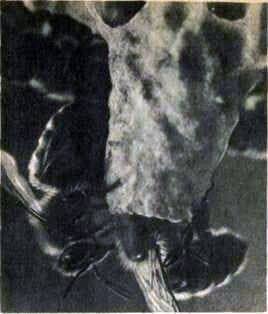
Look at this time in the nest. In the corners and at the bottom of the frames you will see areas with a drone brood.
On the edges of the honeycomb and in the indentations appeared some rounded cells, like caps of acorns or small cups. These are bowls. They will grow young uterus. All these are signs of preparing the family for swarming.
When building cells for growing the queens, the bees retreat from the traditional prismatic hexagonal form and construct special cells that are completely unlike the usual ones, neither in shape, nor in size, nor even in the location in the nest. Biologists for a long time could not explain what serves as a signal for the construction of such cells. Now they explain this by the lack of a mother substance in the family – the secret secreted by the dermal glands of the uterus, which acts on the bees unifyingly and inhibits the manifestation of the instinct of swarming.
Uterus is the successor of the genus, the most important members of the insect community. They are grown under special, exceptionally favorable conditions, the whole family cares for them.
First, bees are cooked under the bowls of the basement, a real foundation. They compact the small area of the honeycomb, strongly ramming the wax. And here, on this capital basis, bees begin to erect a lock for the uterus – not a hexagonal, but a round and spacious cell. Its bottom is concave, cup-shaped, smoothly polished, and not from a combination of rhombuses, like a cell of bee or drone. Bees are used as though by other engineering project and other technical means, although they do everything from the same universal building material – wax platelets. I taught them this, of course, nature, the instinct of reproduction.
Under the influence of swarm bees at certain times, the uterus places eggs in the bowls. Of these, the uterus, the founder of new families, will develop. Since the bowls are in different places in the nest, the uterus finds them and lays eggs in them not at the same time, so the young uterus does not appear all at once, as bees are born on the same honeycomb, but at different times, with some interruption.

Fig. 24. The bees feed the uterine larva.
Even before the hatching of the larva from the egg into the bowl, which is now called the mother liquor, the bees put a special food – royal jelly, rich in the biologically active substances necessary for the rapid growth and development of the queens. Thanks to this “magic” food from a normal fertilized egg, not a working bee, but a queen be born.
With the growth of the uterine larva, the mother liquor builds up, stretches and eventually acquires the shape and size of the acorn.
But the distance between the cells does not allow to place it horizontally, as are all the cells. The bees are therefore being pulled down. He seems to hang between the combs. The larva, as if glued to a thick white creamy mass of royal jelly, never falls out of it.
Apparently, a small intercellular space forced the bees to use more empty seats at the bottom and at the edges of the honeycombs for the construction of the queen cells or specially to gnaw out the cells, to make depressions in the honeycomb.
The walls of the queen cells gradually thicken, become strong, warm. On them even contours of usual hexagonal cells are visible. This is their facing. Because they seem to be patterned. Wax on the mother liquor goes almost a hundred times more than the usual cell. Such a construction allows bees to save developing queens, which grow literally by leaps and bounds, to keep the temperature at the desired level, to ensure free access to the queen cells with oxygen-rich air. Royal larvae need intensive air exchange.
The air temperature near the queen cells is lower than in the region of the bee brood. Apparently, therefore, queen cells are almost always located outside the brood zone.
On the ninth day after the egg was laid, the bees seal the mother liquor. For the development of the uterus it takes only 16 days, whereas for a worker bee – 21, and for a drone – 24 days. Why is the uterus formed in such a short time? It’s all in a special food – highly concentrated miracle milk jelly and in its abundance.
Even before hatching the uterine larva from the egg, bees pour so much royal jelly that it is enough for her for a whole day. And as soon as the larva appears, the milk is constantly poured. Almost half of the mother liquor is filled. The stronger the family, the more milk it is. The larva literally floats in milk and does not have time to eat it for its life, although it has an excellent appetite. After the exit of the uterus in the mother liquor, there is usually a lot of unused food. By the amount of milk remaining, you can determine the quality of the young uterus: the more it is, the better. Good uterus is grown only with abundant food.
The larva, from which the working bee develops, is fed not with uterine, but with beeswax, and they are given only in the first three days. Then the milk is replaced with another food – a mixture of perga and honey. Approximately the same way feed the drone larva. The quality of the feed determines how quickly the larva grows and develops.
A swarm family, while larvae develop in the queen cells, as if someone has replaced them. Before energetic, working from morning till night and in the field, and in the nest, it becomes sluggish. At the tap, there is already no boiling of the departing and arriving pickers. And in the nest, bees stop building honeycomb. To the uterus, which they surrounded with warmth and care, swarm bees become indifferent, almost stop feeding it with milk. The uterus grows thin, every day lays fewer eggs, rests more, becomes able to fly, while a heavy egg-laying womb can not rise into the air.
During development of uterine larvae, swarm bees do not react even to the fact that their nest is open. They sit quietly, indifferently, obscuring all the passages. They occupy the lower branch of the nest, not far from the tap. The streets of this lower building are tumbled. Young bees rarely fly around. Only small groups of old insects continue to fly. You pass by the hive, it seems to be empty, but in fact the bee dwelling is crammed full of insects, brood, fodder. Only on these grounds the beekeeper can unerringly determine: the fetus is formed in the family.
Смородина с медом. Зерна из меда.
Young Beekeeper